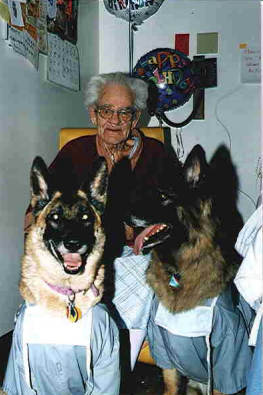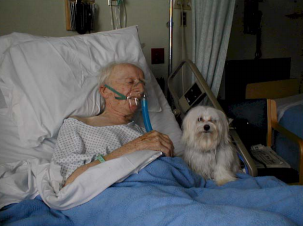by Steve Reiman
The Value of Therapy Dogs “There is no greater therapy than the love of a dog” the sign above my desk proclaims. This animal/human love bond is demonstrated every day in millions of homes around the world. It is also the basis for what is becoming a powerful, common mode of therapy in many long-term health care facilities.
Animals have long been recognized as being a positive force in the healing process. Dogs have a calming and therapeutic effect. They help people cope with the emotional issues related to their illness. They also offer physical contact with another living creature, something that is often missing in an elder’s life. They always invoke pleasant memories of past pets. Best of all, they divert a person’s attention from the pressing problems of the day. For long-term elders, is it not so much the stress of daily problems, but the boredom, loneliness, and lack of control.
Everyone benefits from the mere presence of these canine health care providers, residents, visitors, and staff. When Therapy Dogs walk the floors of a long term facility, it is often a challenge to separate the furry, four-legged therapists from the staff so that they can perform their special magic upon the residents; that’s okay, because therapy dogs provide a much needed break from the routine and stresses of working in a long term facility environment.
Types of Therapy Dogs
There are three types of Therapy Dogs. “Facility Therapy Dogs” and “Animal Assisted Therapy Dogs” assist physical and occupational therapists in meeting goals important to a person’s recovery. The most common Therapy Dogs are “Therapeutic Visitation Dogs”. These dogs are household pets whose owners take time to visit hospitals, nursing homes, detention facilities, and rehabilitation facilities. Therapeutic Visitation Dogs help people who are away from home due to mental or physical illness or court order. These people miss their pets, and a visit from a visitation dog can brighten their day and lift their spirits. For some, it helps motivate them in their therapy or treatment, reminding them of their own pets waiting for them at home.
Though all three types of therapy dogs serve very important (and unique) functions, this article will focus on Therapeutic Visitation Dogs and the benefits that long term residents derive from such therapy.
Benefits
Through their own zest for life, dogs help people maintain a positive. A positive attitude is key to good health, happiness, and staying young.
Dr. Michael McCulloch, a Portland, Oregon, psychiatrist, and Dr. Samuel Corson, of Ohio State University, are two active researchers and experts on why pets excel as therapeutic agents. The primary reasons McCulloch and Corson cite are an individual’s “need to be needed,” and “to touch and be touched.” Further, Dr. McCulloch states, “Touch is one of our primary needs when we’re born and one of our last needs to go.” In long-term facilities, residents are often sorely lacking the feeling that they are needed. Pets allow them, even if for a short time, to be nurturers once again. Also, in a very real physical sense, residents can stroke their warm, furry visitors, facilitating social behavior and encouraging physical movement.
Dogs love almost everyone without prejudice and they eliminate the language barrier. One nurse made this comment about a resident after a visit with a Therapy Dog, “She is the calmest I have seen her today. The dogs have tremendously reduced her high anxiety level.” Dogs, because of their social natures, often genuinely like people and choose to be around them in addition to their owners/handlers. Often, they are aware of illness and sadness and WANT to provide companionship and comfort; they are both intuitive and compassionate. It is always a joy to see them detect sorrow and watch them lick tears away.
Dogs are an antidote to depression – and an easy pill to take. Life in a long-term care facility can be lonely and boring. A visit from a Therapy Dog can break the daily routine and stimulate the mind in dramatic ways. The most serious problem for older adults is not of disease; it’s loneliness. Therapy Dogs and their handlers can make a resident come alive, ultimately, inviting residents back to the world outside the facility in which they live.
In my opinion, older people benefit from pets by:

- Bringing joy and laughter to daily life, which in later years is often uneventful
- Giving the person something to do, talk about and think about, other than him or herself
- Providing a source of touch and affiliation
- Heightening self-confidence, esteem, and a sense of achievement
- Increasing communication between elderly residents and neighbors
- Helping newcomers meet new friends
- Boosting overall morale
- Stimulating exercise and activity
- Helping people cope with illness, loss, and depression.
- Lowering stress levels
- Encouraging communication
- Reminding them of their own pets
Acknowledgements
“Therapy Dogs provide the humans they visit with emotional and physical support. Emotional benefits are difficult to measure, which means therapy dogs help people without knowing exactly why,” says Kathy Davis, author of Therapy Dogs.
Almost ten years ago, almost all nursing homes forbade animals. Now almost half have pet therapy programs. What became popular in Europe spread to the United States in the 1980’s. Initially, pet therapy appeared in hospital crept into long term health care facilities as the benefits were becoming evident. Not only is the effect immediately obvious to the recipient, the service is free of charge.
Dr. Karen M. Allen is a research scientist in medicine at the State University of New York in Buffalo. Dr. Allen’s researchers compared groups of stockbrokers who were on medication to control high blood pressure. The stockbrokers who owned pets experienced half the stress caused increase in blood pressure as those who did not own pets, the study reported. Deborah Lemery, RN, Assistant Administrator of Pillsbury Manor says “Once you see a Senior’s face light up and smile upon seeing one of the Therapy Dogs it is hard to put into words what I think the benefit is. I truly believe that anything that brings even a moment of joy to our residents is worth it. Having the resources through Therapy Dogs of Vermont to do that on a regular basis is most definitely impacting the Quality of life for our residents in a very positive way they look forward to seeing and touching them and they talk about it when they are gone waiting for their return the following week. What a gift they have given our residents and might I add our staff as well.”
An Australian Ph.D student conducted a controlled study of a dog’s impact on a nursing home in Brisbane, Australia. She investigated the perceived levels of confusion, depression, fatigue, tension, and vigor of ninety-five elderly residents at three nursing homes following the introduction of a visiting dog, a resident dog and no dog. The study was conducted over 18 months. In the group visited by the dog, she found reduced levels of fatigue. In the group who had this same dog residing with them she found a decrease in anxiety, confusion, depression, fatigue, and tension. The control group who were visited by the researcher without a dog showed less anxiety and depression. Increased vigor was reported by all groups. Two months after the dog was removed, the benefits remained. Therefore, the introduction of a dog created improvements in more categories than the presence of only a human visitor. The reference for this study is: Crowley-Robinson – Applied Animal Behaviour Science 47: 1996.
Criteria and Testing
A Therapy Dog is more than simply Fido visiting Uncle Harry. Although this may be an acceptable practice with some establishments, Therapy Dogs and their handlers have a great deal more to offer along with a far lower degree of risk. A good therapy dog is one who likes meeting people. It must be gentle, adaptable to new environments, and totally non-aggressive. Dogs are working animals and they usually love the work they are bred or trained to do. Interacting with people is the work of therapy dogs and they always seem excited to visit someone new.
Therapy Dogs are highly trained working dogs. They must be tested, observed, and certified by a national Therapy Dog Registry which provides insurance and identification dog tags. I am aware of three registries in the US; Therapy Dogs, Inc., Therapy Dogs International, and the Delta Society. Local registries also exist. All of the registries require a dog to pass a test that verifies it is neither human nor animal aggressive and that the handler is firmly in control. Dogs are screened to make sure they are suitable for the volunteer work that they will perform. The testers are usually certified by letters of recommendation from dog trainers or others who are similarly qualified. Following certification, the handler/canine candidate accompanies an existing team including a certified evaluator to a hospital or nursing home for three to five observed visits. After the tester and observers sign the proper paperwork, the handler can submit an application for membership in a therapy dog organization.
Liability Concerns
Once the dog/handler team is certified, they become members of the certifying organization and as members, they are covered by the organization’s insurance. The dog must wear a therapy dog tag and the team must abide by the certifying organization’s rules and by the rules of the institutions they visit. All dogs must have records of current vaccinations for membership. They must be kept on a lead that is no longer that 4′ and they must be bathed, groomed, and with trimmed toenails to be allowed in any facility.
In my ten years as founder and president of Therapy Dogs of Vermont, I have rarely seen “mistakes” made by a dog such as defecating in a facility and only when the handler is not completely in sync with the animal. Each time, the handler has been quick to clean up (we always carry a plastic bag and towels) and the staff admits that they have seen much worse from the residents. Only once have I known of a dog to nip a overly zealous visitor and the dog was removed from the program. Therapy Dog organizations are dutifully conscious that one incident can have all members barred from a facility and are ever watchful that all members are always exercising utmost care.
Dog Therapy in Action: The case of Micro and Lessie
 The recreational therapist of Pillsbury Manor is Lessie Reiman, my lovely wife. Once each week, Lessie brings her Maltese named Micro into the facility for the day as part of her activities. Micro proudly wears his Therapy Dog of Vermont Bandanna and volunteer badge. He’s only seven pounds yet he struts around as if he owns the place. Frequently, Lessie will place Micro on a resident’s lap and after a little gentle patting, both of them will completely relax and often fall fast asleep. One resident is progressively more resistant to getting out of bed in the morning. However, on the days that Micro accompanies Lessie to work, all she has to do is mention that Micro is waiting for him in the recreational room. This is enough reason for him to zip out of bed and come out of his room, often without hesitating to change out of his pajamas. Micro is passed from resident to resident until the whole room is enjoying his presence. She encourages them to talk to Micro and to run their fingers through his soft fur.
The recreational therapist of Pillsbury Manor is Lessie Reiman, my lovely wife. Once each week, Lessie brings her Maltese named Micro into the facility for the day as part of her activities. Micro proudly wears his Therapy Dog of Vermont Bandanna and volunteer badge. He’s only seven pounds yet he struts around as if he owns the place. Frequently, Lessie will place Micro on a resident’s lap and after a little gentle patting, both of them will completely relax and often fall fast asleep. One resident is progressively more resistant to getting out of bed in the morning. However, on the days that Micro accompanies Lessie to work, all she has to do is mention that Micro is waiting for him in the recreational room. This is enough reason for him to zip out of bed and come out of his room, often without hesitating to change out of his pajamas. Micro is passed from resident to resident until the whole room is enjoying his presence. She encourages them to talk to Micro and to run their fingers through his soft fur.
Sometimes, the effect of the little dog is magic. A husband wheeled his wife, who has early Alzheimer’s, into the living room where the residents were practicing with percussion instruments. A small instrument was given to the wife whose face was grim and determined not to participate. When she spotted Micro watching her, the gaze of the lady focused completely on the dog – and she began to keep perfect time with her percussion instrument.
The staff tell me that their jobs are easier on the days that Micro is on duty. He creates a happy environment among residents and staff. Everyone becomes more cooperative. Lessie Reiman says “When Micro or other Therapy Dogs are on duty at my facility, the environment is always lighter and the residents happier and more cooperative.” Another way to utilize Therapy Dogs at a facility, a way that is not mutually exclusive from the above method, is to invite members of a Therapy Dog organization to make scheduled visits. I bring my two German Shepherds in to interact with the residents one-on-one in their rooms. I also bring them to the recreation center or living room as a scheduled event. Since some people are afraid of guard dog breeds, I always have mine in costumes. They dress as clowns, or cows, or in outfits related to the season. In hospitals, they dress in hospital scrubs with stethoscopes, masks, and beepers. That alone is enough to get the attention of even those people who aren’t fond of dogs. Sadly, my dogs are the only visitors that some people get and they hug and pat and play with them just as if they are family members.
On a periodic basis, I organize dog shows at long term facilities. We have had as many as 18 dogs with whom we’ll do a very basic obedience demonstration. The residents are eager to enjoy anything the dogs do to entertain them. Then, we’ll often turn the dogs loose to play games with the residents or to play with each other. The energy is often high and exciting and the room is always full of laughter.
How to get Dog Therapy Started at Your Facility
One way is for a staff member to bring a Therapy Dog, his/her own pet, on the job as part of his/her assignment. If you have staff members who have pets which might qualify as a Therapy Dog, encourage them to contact a Therapy Dog registry for a list of the nearest testers and evaluators. Once certified, they could bring their animals to work at your facility on a periodic basis just as Lessie brings Micro. You might implement a program more quickly by contacting a national registry for a list of members who are in the area. These members could then start a regular program under your guidance which would mean bringing their registered dogs in to visit residents on a one-on-one basis in the resident’s rooms or to a social gathering in a recreation room.
In conclusion
While it may be difficult to quantify the benefits of dog therapy with hard scientific, empirical fact, the magical interaction possible between animal and human can be unmistakable. Tears dry. Frowns transform to smiles. Inactive hands caress soft fur. Silence becomes a conversation of coos whispered in a dog’s ear. Dogs offer themselves to patients with joy, unconditional love, great affection, and boundless patience. They can have a profound ability to touch residents not engaged by other kinds of therapies. Perhaps this is because they offer themselves in a non-threatening, wordless way that speaks love and attention.
Indeed, there is no greater therapy than the love of a dog.
References
http://therapydogs.org
http://www.dog-play.com
http://www.on8.com/navpettheme.html
Therapy Dogs – by Kathy Davis (Howell Book House)
Annotated Bibliography – Pet Therapy & Animal-;Assisted Therapy Muschel, I.J. (1984).
Reichert, E. (1994). Play and animal-assisted therapy: A group-treatment model for sexually abused girls ages 9-13. Family Therapy, 21 (1), 55-62.
Voelker, R. (1995). Puppy love can be therapeutic, too. The Journal of the American Medical Association, 274 (24), 1897-1900.
Draper, R.J., Gerber, G.J., & Layng, E.M. (1990). Defining the role of animals in psychotherapy. Psychiatric Journal of the University of Ottawa. 15(3), 169-172.
Therapy Dogs: Training Your Dog to Reach Others by Kathy Diamond Davis (Howell Books, 1992)
Steve Reiman is the Former President of Therapy Dogs of Vermont (TDV), an organization he founded which brings highly trained, registered, and insured working dogs into hospitals and nursing homes to improve the emotional health of the patients and residents. TDV is a totally non-profit all-volunteer organization although some of our four-footed members get paid with dog biscuits.
